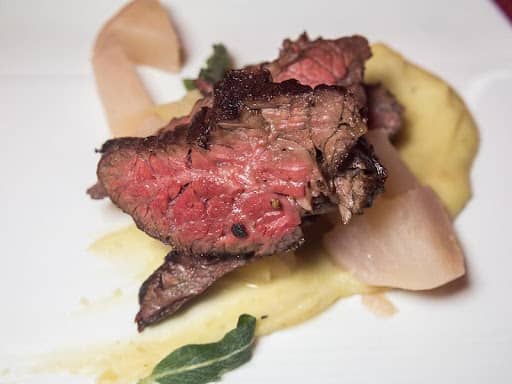
Hanger steak is much less talked about than filet mignon, but it’s surprisingly similar in texture. Filet mignon is well-known for being tender to the point of requiring minimal chewing to enjoy each bite. But, hanger steak is in a close second place for that melt-in-your-mouth tenderness. What other similarities and differences exist between the two? Check out our guide for all the details.
What is Hanger Steak?
Hanger steak is sometimes confused with a filet mignon because it’s also known as a hanging tenderloin. Filet mignon comes from the tenderloin, so you might see why these names can be interchanged easily. However, unlike filet mignon, the hanger steak comes from an area of a cow called the plate, which is in the belly area. It’s an area that doesn’t move a lot and, therefore, is more fatty than muscular, leaving the hanger steak and other portions of meat very tender.
What is a Filet Mignon?
Filet mignon is from the tenderloin portion of a cow, which is up toward the back of the animal, completely opposite from a hanger steak. The tenderloin area starts at the rear end of the cow and stretches in toward the middle, ending in the short loin area. A small portion of the tenderloin found in the short loin becomes the filet mignon. Usually, butchers get just two portions of filet mignon from one cow, making it easy to see why this cut can be pricey.
How Did the Filet Mignon and Hanger Steak Get Their Names?
Filet mignon is a French name, roughly translating to delicate piece of meat. This portion of beef is, indeed, delicate compared to others, which is why it’s one of the most prized pieces of steak for upscale dishes.
The hanger steak or hanging tenderloin got its name from its position on the underbelly of the cow. It “hangs” off the cow’s stomach area and, because it resembles the actual tenderloin when cut, it became dubbed the hanging tenderloin.
How Do Hanger Steaks and Filet Mignon Differ?
Hanger steak and filet mignon have some similarities, but they also differ in many ways. Here’s how they compare.
Nutrition
Nutrition-wise, hanger steak and filet mignon are closely related. As we mentioned, these steaks are fattier than they are muscular, so they shouldn’t be considered lean steak cuts. You can expect between 7-14 grams of saturated fat in a serving of either one, depending on what type of beef it is. Generally, USDA Choice tends to have less fat content than, say, Wagyu beef. As far as calories, vitamins, and minerals, you won’t find much of a difference between hanger steak and filet mignon.
Tenderness
Although both the hanger steak and filet mignon are exceptionally tender, the filet mignon has a slight edge here. This cut’s bread and butter is its texture, which creates a steak that barely requires chewing. With that said, the hanger steak can reach a similar tenderness when cooked properly. The key is cooking it to medium rare and getting a nice sear on the outside.
Cost
The filet mignon usually costs more per pound than a hanger steak. Prices vary by geographic location and store, but a hanger steak is often priced between $15-$30 per pound, while filet mignon can run anywhere from $20-$50 per pound. And, if you’re ordering filet mignon from a restaurant, be prepared to spend much more on it as a dish than you would hanger steak.
Marbling and Taste
Marbling refers to the white lines of fat that run through a piece of beef. When this fat cooks down, it can help tenderize the meat. A filet mignon has very little marbling, but a hanger steak has a decent amount. Fortunately, marbling isn’t necessary for filet mignon, which is already tender on its own. But you may notice a flavor difference. Hanger steak has a much more pronounced beef flavor than filet mignon, which is perhaps the most mildly flavored steak.
Size and Proportions
The most notable difference between these two cuts is their appearance. Hanger steaks are longer, narrower, and thinner. Meanwhile, filet mignon are round and thick, but their thickness can make them challenging to cook.
Bone and Fat Content
Both of these cuts have a decent amount of fat because of where they sit on a cow’s body. That fat content lends to their desirable texture. As for bones, a hanger steak never includes one because its anatomical position isn’t near any bones. A filet mignon, however, sometimes includes a bone, although usually only by special request from a butcher’s customer. Most often, especially in restaurants, these cuts are boneless.
Method of Preparation
You can use multiple cooking methods for hanger steak and filet mignon. However, due to its thickness, filet mignon is often pan-seared and finished off in the oven or cooked between high and low heat areas of a grill to help it reach the right internal temperature. The much thinner hanger steak can be fully seared and finished in a pan or on the grill.
Conclusion: Hanger Steak vs. Filet Mignon
There’s much to love about hanger steak and filet mignon. While filet mignon is often seen as a prized steak, hanger steak is highly underrated. It’s more affordable and can be an excellent alternative to filet mignon for someone who prefers bolder steak flavor. Need some inspiration to cook these cuts? Check out Steak University’s steak recipes.

